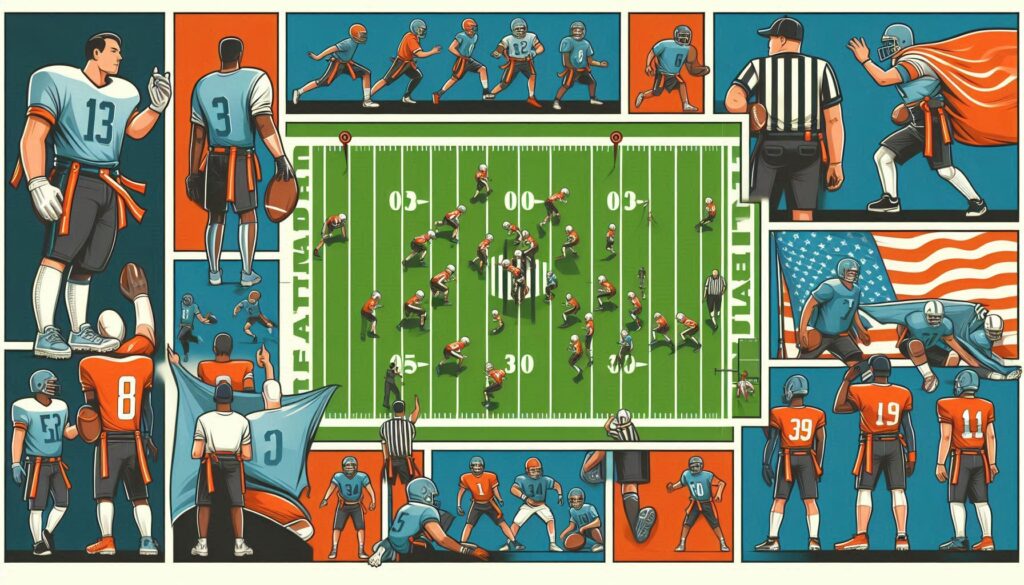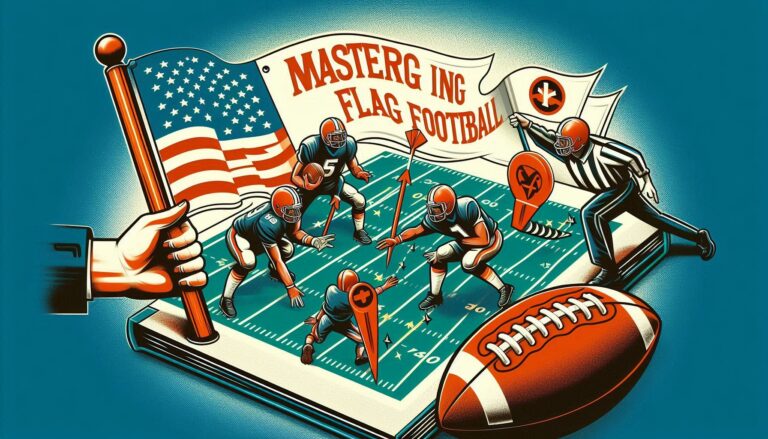Flag football is a fast-paced, exciting variation of traditional American football that emphasizes skill and strategy over physical contact. Whether you’re a seasoned player or new to the game, understanding the complete guide to flag football—including its rules, scoring system, and line of scrimmage—can enhance your appreciation and performance. This guide delves into the essentials of flag football, making it easier to grasp the fundamentals and excel on the field.
Introduction to Flag Football Rules

Understanding Flag Football Rules
Flag football is designed to provide a less physical alternative to tackle football while maintaining the core elements of the game. The primary objective remains the same: score points by advancing the ball into the opponent’s end zone. However, instead of tackling players to stop their progress, defenders pull a flag from the ball carrier’s belt to signify a stoppage of play. This rule change significantly reduces injuries and promotes a more strategic style of play.
Each game typically consists of two halves, with each team having an equal opportunity to possess the ball and attempt to score. The rules are designed to ensure fairness and maintain a high level of competition. Understanding these rules is crucial for both players and spectators to fully appreciate the dynamics of flag football.
Basic Rules of Flag Football
Flag football rules can vary slightly depending on the league or level of play, but the fundamentals remain consistent. Each team fields a roster of players, usually ranging from 5 to 8 players per side. The game begins with a kickoff or a similar method to determine possession. Offensive plays are initiated from the line of scrimmage, and the objective is to advance the ball downfield and score a touchdown.
Key rules include the requirement for each player to wear a flag belt, the prohibition of physical tackles, and the necessity for the offense to advance the ball at least ten yards within a set number of plays or “downs.” Violations of these rules, such as holding or illegal flag pulls, result in penalties that can impact the outcome of the game.
Scoring in Flag Football

How Many Points is a Touchdown in Flag Football?
In flag football, a touchdown is worth six points. This scoring method mirrors traditional football, where the objective is to reach the opponent’s end zone and score by crossing the goal line. After scoring a touchdown, the team has the option to attempt a conversion play for additional points, which can vary depending on the league’s specific rules.
The scoring system in flag football emphasizes strategic play, as teams must carefully plan their offensive and defensive strategies to maximize their scoring opportunities and prevent the opposition from scoring. Understanding how points are awarded and the options available for conversion can significantly influence game strategies.
How much is a Touchdown Worth in Flag Football?
As previously mentioned, a touchdown in flag football is worth six points. Following the touchdown, teams can attempt a conversion play, which may add one or two additional points, depending on the league’s rules. A successful one-point conversion typically involves a shorter play from the 5-yard line, while a two-point conversion requires a play from the 10-yard line.
These conversion plays provide teams with an opportunity to score extra points and can be a pivotal factor in close games. Teams must weigh the risks and benefits of attempting conversions versus settling for the standard six points, adding a layer of strategic decision-making to the game.
The Line of Scrimmage in Flag Football

What is the Line of Scrimmage in Flag Football?
The line of scrimmage in flag football is the starting point for each play, marking the location where the offensive team must initiate their play. It is a crucial aspect of the game, as it dictates the placement of the ball and the formation of the offensive and defensive teams. The line of scrimmage is established at the point where the ball is spotted by the referee after the previous play.
Understanding the line of scrimmage is essential for both offensive and defensive strategies. The offensive team must work within the constraints of this line to advance the ball, while the defensive team aims to disrupt their progress and force a turnover or incomplete play.
The Role of the Line of Scrimmage in Game Play
The line of scrimmage serves several critical functions in flag football. It helps maintain order and fairness by ensuring that each play begins from a designated spot on the field. Additionally, it influences the strategies employed by both teams. The offense must plan its plays and routes based on its position relative to the line of scrimmage, while the defense positions itself to counteract the offensive strategies and minimize the gain of yards.
Penalties can also impact the line of scrimmage. For example, a false start or offside penalty can result in a loss of yards, pushing the offensive team further from their goal. Conversely, defensive penalties such as encroachment can result in a favorable position for the offense. Understanding these dynamics is key to mastering the game of flag football.
Basic Concepts of Flag Football

Overview of Flag Football Basics
Flag football combines the excitement of traditional football with a focus on skill and strategy rather than physical contact. Players wear belts with flags attached, which are pulled by defenders to stop the play. This non-contact approach makes the game accessible to a wider range of participants, including younger players and those looking for a less physically demanding alternative to tackle football. The game is typically played on a smaller field compared to traditional football, and each team has a set number of plays or downs to advance the ball and score. The basic objective is to outscore the opponent by successfully advancing the ball into the end zone and defending against the opponent’s offensive plays. Understanding these basic concepts provides a foundation for more advanced strategies and gameplay
Key Rules and Scoring in Flag Football
Flag football shares many similarities with traditional football but with key differences in rules and scoring. In addition to touchdowns, other scoring opportunities include safeties and conversion attempts. Teams must also adhere to specific rules regarding flag pulling, illegal contact, and play formation. Penalties can impact field position and game flow, making it important for players to understand and follow the rules to maximize their performance.
Players can develop effective strategies and enhance their overall gameplay by mastering the key rules and scoring methods of flag football. This knowledge is essential for both new and experienced players looking to excel in this exciting and dynamic sport.






